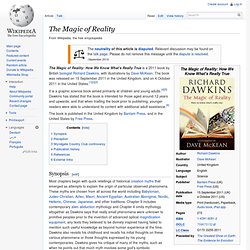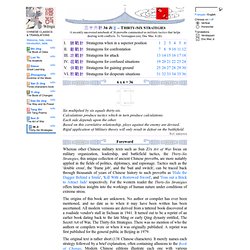

100 Must Read Books: The Man’s Essential Library. The Magic of Reality: How We Know What's Really True. The Magic of Reality: How We Know What's Really True is a 2011 book by British biologist Richard Dawkins, with illustrations by Dave McKean.

The book was released on 15 September 2011 in the United Kingdom, and on 4 October 2011 in the United States.[1][2][3] It is a graphic science book aimed primarily at children and young adults.[4][5] Dawkins has stated that the book is intended for those aged around 12 years and upwards, and that when trialling the book prior to publishing, younger readers were able to understand its content with additional adult assistance.[6] Synopsis[edit] Most chapters begin with quick retellings of historical creation myths that emerged as attempts to explain the origin of particular observed phenomena.
These myths are chosen from all across the world including Babylonian, Judeo-Christian, Aztec, Maori, Ancient Egyptian, Australian Aboriginal, Nordic, Hellenic, Chinese, Japanese, and other traditions. Reception[edit] Wyndgate Country Club controversy[edit] Proust was a neuroscientist - Jonah Lehrer. Secrets of the samurai: a survey of the martial arts of feudal Japan - Oscar Ratti, Adele Westbrook. The unspoken way: haragei : silence in Japanese business and society - Michihiro Matsumoto.
I Am a Cat - Sōseki Natsume, Aiko Ito, Graeme Wilson. Ten Nights' Dreams - Soseki Natsume. Triangular theory of love. The triangular theory of love is a theory of love developed by psychologist Robert Sternberg. In the context of interpersonal relationships, "the three components of love, according to the triangular theory, are an intimacy component, a passion component, and a decision/commitment component. "[1] "The amount of love one experiences depends on the absolute strength of these three components, and the type of love one experiences depends on their strengths relative to each other.
Early theories of love[edit] One of the first theories of love was developed by Sigmund Freud. Another theory was introduced by Maslow. Yet another theory, one about Being love, was developed by Reik. When theories about love moved from being clinically based to being socially and personality based, they became focused on types of love, as opposed to becoming able to love. Elaboration of Sternberg's triangular theory of love[edit] Companionate love follows passionate love. Sternberg created his triangle next. Xiiao Yee. Thirty-Six Strategies - 36 Ji. A recently uncovered notebook of 36 proverbs commented as military tactics that helps dealing with conflicts.

Tr. Verstappen (en), Doc Mac Jr (fr). Whereas other Chinese military texts such as Sun Zi's Art of War focus on military organization, leadership, and battlefield tactics, the Thirty-Six Strategies, this unique collection of ancient Chinese proverbs, are more suitably applied in the fields of politics, diplomacy, and espionage. Tactics such as the 'double cross', the 'frame job', and the 'bait and switch', can be traced back through thousands of years of Chinese history to such proverbs as 'Hide the Dagger Behind a Smile', 'Kill With a Borrowed Sword', and 'Toss out a Brick to Attract Jade' respectively. For the western reader the Thirty-Six Strategies offers timeless insights into the workings of human nature under conditions of extreme stress.
The origins of this book are unknown. The original text is rather short (138 Chinese characters). Koskov – 2007/12/10 Anon. – 2007/12/10. Book excerpt: Wing Chun Warrior @ The Blacksmith Books blog. Here we print an excerpt from Ken Ing’s Wing Chun Warrior — the biography of Duncan Leung, a kung fu master who studied under the famous Yip Man.

Scroll to the end for cartoons which illustrate the story! Hong Kong, 1958 Subdue the dragon, tame the tiger — Journey to the West Wu Cheng-en was an author of the Ming Dynasty who wrote Journey to the West, one of the four classical Chinese novels. In Buddhist mythology, there were two Buddhist arhats ( luo han – an eminent monk who has achieved enlightenment), one of whom subdued a dragon with incantations and the other who tamed a tiger with an abbot’s staff. It may be hard to believe, but one day Bruce Lee and Duncan Leung were beaten one after the other on the same day by a seasoned pugilist. The American boys handy book - Daniel Carter Beard. Physical, Emotional, Mental, and Spiritual Health. Home -> Free Articles -> Physical, Emotional, Mental, and Spiritual Health By Mary Kurus How Do We View Health Today: We are taught in our western culture to think in terms of pieces of ideas or concepts rather than integrated complete ideas and concepts.

We look at our bodies, minds, emotions and spirit as if each part is fully separate from the other rather than totally intertwined. Western society rewards specialization, the examination of a piece of the whole. This fragmented approach has lead us to look at health in a compartmentalized manner rather than as the management of a totality. We separate our spiritual lives into a separate box or a specific time for worship or prayer.